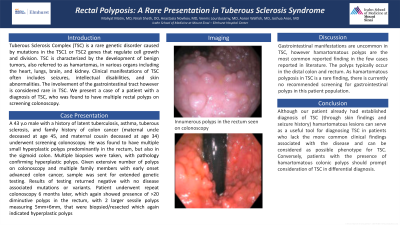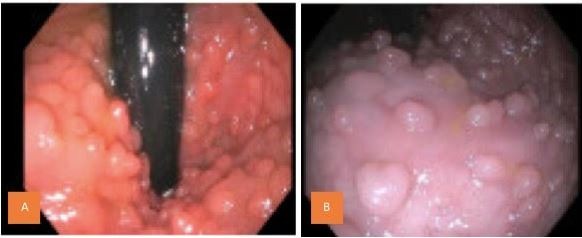Tuesday Poster Session
Category: Colon
P3057 - Rectal Polyposis: A Rare Presentation in Tuberous Sclerosis Syndrome
Tuesday, October 24, 2023
10:30 AM - 4:00 PM PT
Location: Exhibit Hall

Has Audio

Maliyat M. Matin, MD
Icahn School of Medicine Mount Sinai - Elmhurst Hospital Center
Elmhurst, New York
Presenting Author(s)
Maliyat M. Matin, MD1, Nirali Sheth, DO2, Anastasia Novikov, MD3, Vennis Lourdusamy, MD4, Aaron Walfish, MD4, Joshua Aron, MD5
1Icahn School of Medicine Mount Sinai - Elmhurst Hospital Center, Elmhurst, NY; 2Icahn School of Medicine Mount Sinai - Elmhurst Hospital Center, Rego Park, NY; 3Elmhurst Hospital Center/ Icahn School of Medicine at Mount Sinai, Elmhurst, NY; 4Elmhurst Hospital Center/ Icahn School of Medicine, Elmhurst, NY; 5Icahn School of Medicine at Mount Sinai, NYC Health + Hospitals/Elmhurst, Queens, NY
Introduction: Tuberous Sclerosis Complex (TSC) is a rare genetic disorder caused by mutations in the TSC1 or TSC2 genes that regulate cell growth and division. TSC is characterized by the development of benign tumors, also referred to as hamartomas, in various organs including the heart, lungs, brain, and kidney. Clinical manifestations of TSC often includes seizures, intellectual disabilities, and skin abnormalities. The involvement of the gastrointestinal tract however is considered rare in TSC. We present a case of a patient with a diagnosis of TSC, who was found to have multiple rectal polyps on screening colonoscopy.
Case Description/Methods: A 43 y.o male with a history of latent tuberculosis, asthma, tuberous sclerosis, and family history of colon cancer (maternal uncle deceased at age 45, and maternal cousin deceased at age 34) underwent screening colonoscopy. He was found to have multiple small hyperplastic polyps predominantly in the rectum, but also in the sigmoid colon. Multiple biopsies were taken, with pathology confirming hyperplastic polyps. Given extensive number of polyps on colonoscopy and multiple family members with early onset advanced colon cancer, sample was sent for extended genetic testing. Results of testing returned negative with no disease associated mutations or variants. Patient underwent repeat colonoscopy 6 months later, which again showed presence of >20 diminutive polyps in the rectum, with 2 larger sessile polyps measuring 5mm+6mm, that were biopsied/resected which again indicated hyperplastic polyps.
Discussion: Gastrointestinal manifestations are uncommon in TSC, however hamartomatous polyps are the most common reported finding in the few cases reported in literature. The polyps typically occur in the distal colon and rectum. As hamartomatous polyposis in TSC is a rare finding, there is currently no recommended screening for gastrointestinal polyps in this patient population. Although our patient already had established diagnosis of TSC (through skin findings and seizure history hamartomatous lesions can serve as a useful tool for diagnosing TSC in patients who lack the more common clinical findings associated with the disease and can be considered as possible phenotype for TSC. Conversely, patients with the presence of hamartomatous colonic polyps should prompt consideration of TSC in differential diagnosis.

Disclosures:
Maliyat M. Matin, MD1, Nirali Sheth, DO2, Anastasia Novikov, MD3, Vennis Lourdusamy, MD4, Aaron Walfish, MD4, Joshua Aron, MD5. P3057 - Rectal Polyposis: A Rare Presentation in Tuberous Sclerosis Syndrome, ACG 2023 Annual Scientific Meeting Abstracts. Vancouver, BC, Canada: American College of Gastroenterology.
1Icahn School of Medicine Mount Sinai - Elmhurst Hospital Center, Elmhurst, NY; 2Icahn School of Medicine Mount Sinai - Elmhurst Hospital Center, Rego Park, NY; 3Elmhurst Hospital Center/ Icahn School of Medicine at Mount Sinai, Elmhurst, NY; 4Elmhurst Hospital Center/ Icahn School of Medicine, Elmhurst, NY; 5Icahn School of Medicine at Mount Sinai, NYC Health + Hospitals/Elmhurst, Queens, NY
Introduction: Tuberous Sclerosis Complex (TSC) is a rare genetic disorder caused by mutations in the TSC1 or TSC2 genes that regulate cell growth and division. TSC is characterized by the development of benign tumors, also referred to as hamartomas, in various organs including the heart, lungs, brain, and kidney. Clinical manifestations of TSC often includes seizures, intellectual disabilities, and skin abnormalities. The involvement of the gastrointestinal tract however is considered rare in TSC. We present a case of a patient with a diagnosis of TSC, who was found to have multiple rectal polyps on screening colonoscopy.
Case Description/Methods: A 43 y.o male with a history of latent tuberculosis, asthma, tuberous sclerosis, and family history of colon cancer (maternal uncle deceased at age 45, and maternal cousin deceased at age 34) underwent screening colonoscopy. He was found to have multiple small hyperplastic polyps predominantly in the rectum, but also in the sigmoid colon. Multiple biopsies were taken, with pathology confirming hyperplastic polyps. Given extensive number of polyps on colonoscopy and multiple family members with early onset advanced colon cancer, sample was sent for extended genetic testing. Results of testing returned negative with no disease associated mutations or variants. Patient underwent repeat colonoscopy 6 months later, which again showed presence of >20 diminutive polyps in the rectum, with 2 larger sessile polyps measuring 5mm+6mm, that were biopsied/resected which again indicated hyperplastic polyps.
Discussion: Gastrointestinal manifestations are uncommon in TSC, however hamartomatous polyps are the most common reported finding in the few cases reported in literature. The polyps typically occur in the distal colon and rectum. As hamartomatous polyposis in TSC is a rare finding, there is currently no recommended screening for gastrointestinal polyps in this patient population. Although our patient already had established diagnosis of TSC (through skin findings and seizure history hamartomatous lesions can serve as a useful tool for diagnosing TSC in patients who lack the more common clinical findings associated with the disease and can be considered as possible phenotype for TSC. Conversely, patients with the presence of hamartomatous colonic polyps should prompt consideration of TSC in differential diagnosis.

Figure: Innumerous polyps in the rectum
Disclosures:
Maliyat Matin indicated no relevant financial relationships.
Nirali Sheth indicated no relevant financial relationships.
Anastasia Novikov indicated no relevant financial relationships.
Vennis Lourdusamy indicated no relevant financial relationships.
Aaron Walfish indicated no relevant financial relationships.
Joshua Aron indicated no relevant financial relationships.
Maliyat M. Matin, MD1, Nirali Sheth, DO2, Anastasia Novikov, MD3, Vennis Lourdusamy, MD4, Aaron Walfish, MD4, Joshua Aron, MD5. P3057 - Rectal Polyposis: A Rare Presentation in Tuberous Sclerosis Syndrome, ACG 2023 Annual Scientific Meeting Abstracts. Vancouver, BC, Canada: American College of Gastroenterology.
